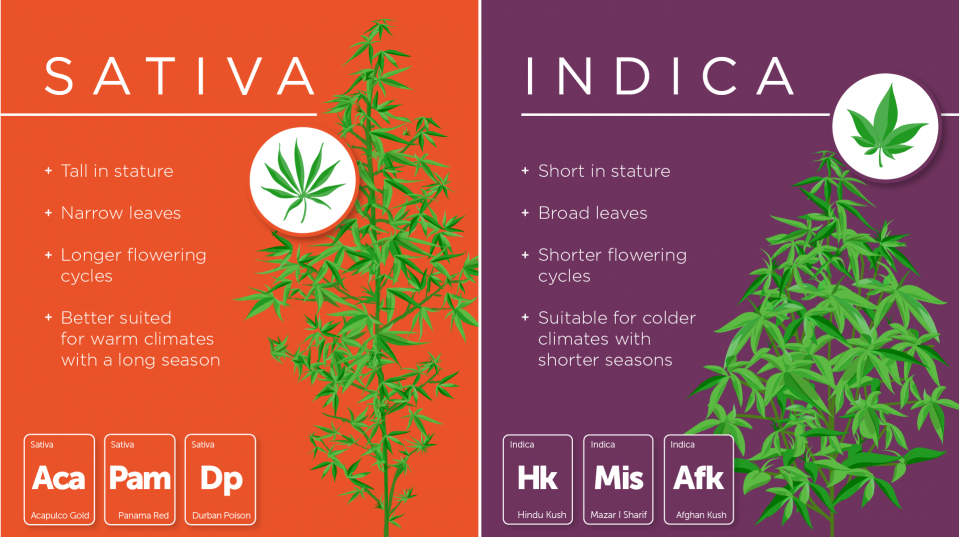When browsing cannabis strains or purchasing cannabis at a shop, you may notice strains are commonly broken up into two distinct groups: sativa and indica strains. Most consumers have used these two cannabis types as a touchstone for predicting effects:
- Indica strains are believed to be physically sedating, perfect for relaxing with a movie or as a nightcap before bed.
- Sativa strains tend to provide more invigorating, uplifting cerebral effects that pair well with physical activity, social gatherings, and creative projects.
This belief that sativa and indica strains deliver distinct effects is so deeply rooted in the cannabis culture that budtenders typically begin their strain recommendations by asking you which of these three types you prefer.
However, data collected by cannabis researchers suggests these categories aren’t as prescriptive as one might hope. In other words, there’s little evidence to suggest that sativa and indica strains exhibit a consistent pattern of chemical profiles that would make one inherently sedating and the other uplifting.
We do know that indica and sativa cannabis strains look different and grow differently, but this distinction is primarily useful only to cannabis cultivators. So how exactly did the words “indica” and “sativa” make it into the vernacular of cannabis consumers worldwide, and to what extent are they meaningful when choosing a strain?
Indica and Sativa: Origin and Evolution of the Terms

The words “indica” and “sativa” were introduced in the 18th century to describe different species of cannabis: Cannabis sativa and Cannabis indica. The term sativa, named by Carl Linneaus, described hemp plants found in Europe and western Eurasia, where it was cultivated for its fiber and seeds. Cannabis indica, named by Jean-Baptiste Lamarck, describes the psychoactive varieties discovered in India, where it was harvested for its seeds, fiber, and hashish production.
Although the cannabis varieties we consume largely stem from Cannabis indica, both terms are used–even if erroneously–to organize the thousands of strains circulating the market today.
Here’s how terms have shifted since their earliest botanical definitions:
- Today, “sativa” refers to tall, narrow-leaf varieties of cannabis, thought to induce energizing effects. However, these narrow-leaf drug (NLD) varieties were originally Cannabis indica ssp. indica.
- “Indica” has come to describe stout, broad-leaf plants, thought to deliver sedating effects. These broad-leaf drug (BLD) varieties are technically Cannabis indica ssp. afghanica.
- What we call “hemp” refers to the industrial, non-intoxicating varieties harvested primarily for fiber, seeds, and CBD. However, this was originally named Cannabis sativa.
What Cannabis Strain Is Right for You?
Before choosing indica or sativa, it is important to consider a third cannabis type: hybrid. Hybrids are thought to fall somewhere in between the indica-sativa spectrum, depending on the traits they inherit from their parent strains.
This may seem overwhelming, especially if you’re a budtender whose job it is to guide consumers to the right product. Ironically, the more you know about cannabis, the more questions seem to arise. But understanding the basic properties of cannabinoids, terpenes, and consumption methods will often answer the most fundamental question of cannabis: What product is right for me?
Here are some helpful beginner resources to get you started:
- Cannabis Strain Recommendations for Beginners and Low-Tolerance Consumers
- Cannabis Product Recommendations for First-Time Consumers
- The Best Cannabis Strains and Products for Every Situation
- How to Find the Best Experience and High for You
For budtenders, be cognizant of the basis of your recommendation, especially for customers treating medical ailments. Educate yourself on the benefits of different cannabinoids and terpenes, and use that knowledge to make a recommendation beyond the oversimplifications and marketing tactics embedded in the sativa/indica distinction.
“In the future, I’d like to see the terms ‘sativa’ and ‘indica’ be abandoned in favor of a system in which the consumer tells the budtender what s/he would like to have in terms of effects from their cannabis selection, and then study the offerings together,” Russo said. “If a buzz is all that is wanted, then high THC with limonene or terpinolene would be desirable. If someone, in contrast, has to work or study and treat their pain, then high CBD with low THC plus some alpha-pinene to reduce short-term memory impairment would be the ticket.” Cannabis may not be as simple as we’d like, but its diversity and complexity is what makes it such a remarkable plant and tool for consumers of all types.
